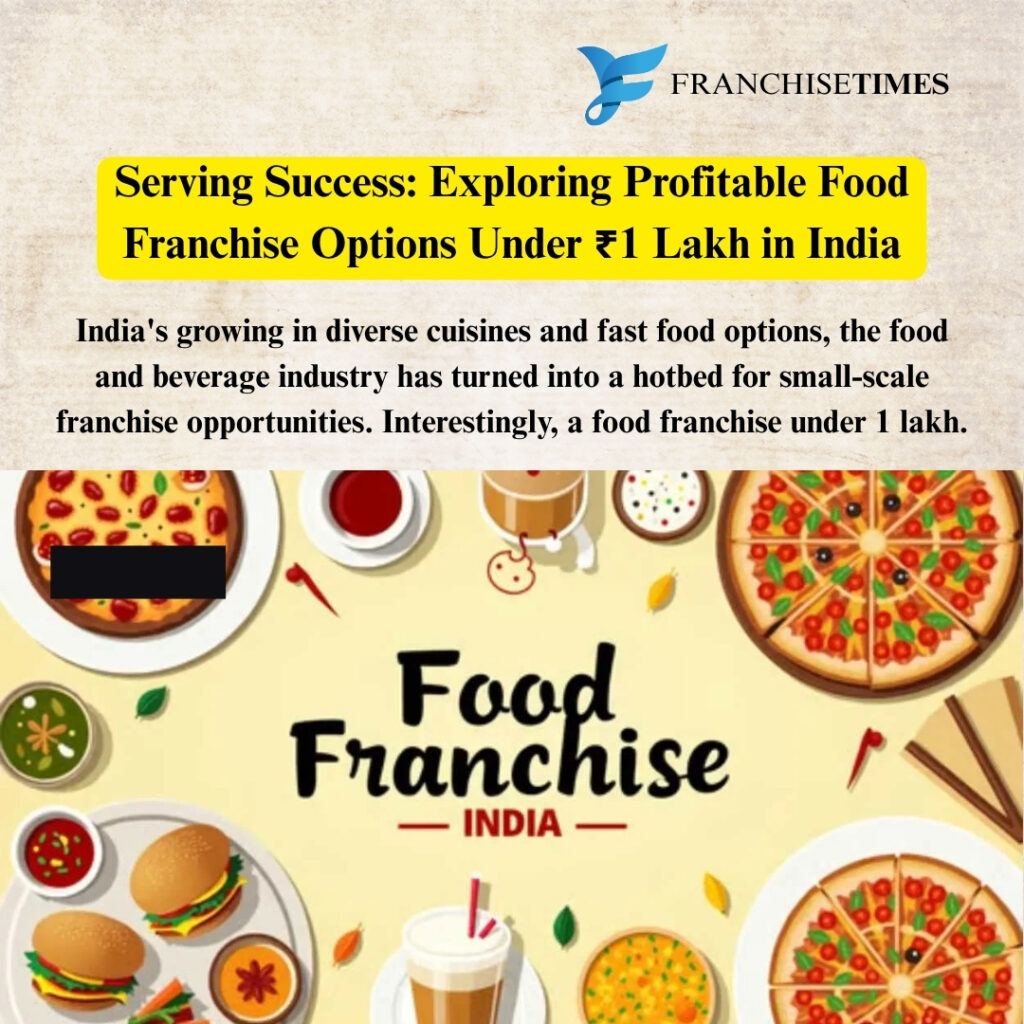Serving Success: Exploring Profitable Food Franchise Options Under ₹1 Lakh in India
In today’s entrepreneurial landscape, starting a business doesn’t necessarily demand massive capital. With India’s growing appetite for diverse cuisines and fast food options, the food and beverage industry has turned into a hotbed for small-scale franchise opportunities. Interestingly, a Low investment food franchise is no longer a myth—it’s a smart possibility for aspiring business owners.
Rather than spending lakhs on infrastructure or branding, budding entrepreneurs are now able to tap into trusted models that offer both brand value and affordability. This blog explores how you can join this booming industry with minimal investment and still make significant profits.

Whether you are a student, a homemaker, or a part-time entrepreneur, there are scalable options for everyone. Let’s delve into the practical, low-investment world of budget-friendly food franchises in India.
1. Why Low-Cost Food Franchises Are the Future of Indian Entrepreneurship
The Indian food industry has witnessed exponential growth over the past decade. Rapid urbanization, increasing disposable incomes, and evolving consumer preferences have created a perfect storm for foodpreneurs. More importantly, the desire for convenience, consistency, and brand trust has made the franchise model particularly popular.
In contrast to high-capital ventures that require extensive planning and operational setups, low-investment food franchises provide a structured model with ready-made solutions. This often includes branding, equipment guidance, initial stock, and even digital marketing tools.
Moreover, setting up a food franchise under 1 lakh in India is incredibly flexible. Many of these models operate from carts, kiosks, or home-based kitchens—thus removing the heavy burden of rent or large staffing.
What makes these opportunities even more exciting is their fast breakeven potential. In some cases, franchisees recover their investment within 3–6 months, especially when located in high-footfall areas such as educational campuses, metro stations, or shopping complexes.
In essence, the new wave of food franchises proves that big results can indeed come from small beginnings.
2. Types of Low-Investment Food Franchise Models You Can Explore
Before choosing a franchise, it’s crucial to understand the operational model that aligns with your goals, location, and time availability. Not every franchise demands a storefront or full-time commitment. Below are the primary types of food businesses you can launch within this budget range:
A. Food Cart Franchise
Mobile food carts have transformed the street food culture in India. These carts, often pre-fabricated by the franchisor, serve everything from momos to hot dogs. They attract large crowds due to their visibility and affordable pricing.
B. Cloud Kitchen Franchise
With the rise of online food delivery apps, cloud kitchens or delivery-only food outlets have become a major trend. These require very little space and work best for entrepreneurs who want to operate from home or a rented kitchen space.
C. Kiosk-Based Franchise
Small kiosks in shopping malls, tech parks, or metro stations can be great profit centers. These setups are compact but powerful in terms of customer reach. Many tea, coffee, and snacks brands operate under this model.
D. Home-Based Food Businesses
Some franchises allow you to operate from your own kitchen by providing ingredients, training, and branding support. This is an ideal option for homemakers or culinary enthusiasts.
E. Pop-Up Stall Franchises
These temporary food stalls work during exhibitions, fairs, and local events. The low set-up cost and high volume during events make them a great part-time or seasonal opportunity.
With each of these models, your investment is mostly directed toward essentials like initial raw materials, franchise fee, cart/kiosk setup, and marketing.
3. What to Expect from a Food Franchise Under ₹1 Lakh
Let’s take a closer look at what’s typically included when you purchase a food franchise under 1 lakh in India. While the offerings vary depending on the brand, some key components remain standard across the industry:
1. Brand Licensing & Usage Rights
You’ll get the legal right to operate under the brand’s name, logo, and signature dishes. This lends instant credibility and customer trust to your business.
2. Raw Materials or Starter Kits
Most low-cost franchises provide a startup kit containing ingredients, packaging materials, and sometimes uniforms to get you started right away.
3. Training & SOPs
Even if you don’t have prior experience, franchisors offer training sessions either online or offline. These cover food preparation, hygiene standards, inventory management, and POS systems.
4. Marketing Collateral
To help you attract customers from day one, the brand often includes posters, banners, menus, and digital marketing creatives in the package.
5. Technical Support
Some franchises also provide ongoing support such as vendor contacts, supply chain assistance, or integration with food delivery apps like Zomato and Swiggy.
Of course, these inclusions vary from brand to brand. However, in most scenarios, a combination of these five features forms the backbone of your franchise launch kit.
4. How to Choose the Right Low-Cost Food Franchise
Finding a food franchise under 1 lakh in India is the first step. The next—and more crucial—step is selecting the right one. Here are several factors you must evaluate to ensure long-term success:
✅ A. Brand Reputation
It’s tempting to go for a new and trendy name, but it’s safer to stick with a brand that has proven customer trust and visibility.
✅ B. Menu Appeal
Choose a brand that offers high-demand, low-preparation-time items such as street snacks, beverages, or regional delicacies.
✅ C. Location Compatibility
Does your preferred brand work in high-footfall locations, or is it suitable for residential zones? Be sure to match the franchise’s strength with your chosen location.
✅ D. Margin & Pricing Model
Ensure that the product pricing allows for at least 30–40% profit margins. Also, check if the franchisor charges any royalty or commission on monthly sales.
✅ E. Reviews from Existing Franchisees
Speak to current franchise owners if possible. Their feedback will give you insights into support, product quality, and real-time earnings.
Don’t rush into a decision solely based on cost. A thorough comparison of at least 3–5 franchise options can save you both money and future stress.
5. Scaling and Marketing Your Low-Investment Food Franchise
Getting started is only half the journey. To maximize your earnings from a food franchise under 1 lakh in India, you must actively market and scale your business. Here’s how:
A. Local Digital Marketing
Use free tools like Google Business Profile, Instagram, and Facebook to promote your daily specials, customer reviews, and seasonal offers.
B. Partner with Delivery Platforms
Register your franchise outlet on Swiggy, Zomato, and Dunzo. This increases your reach and customer base without any additional physical infrastructure.
C. Leverage Word-of-Mouth
Offer discounts for referrals and create loyalty programs for repeat customers. Personal interactions and excellent service go a long way.
D. Home & Office Delivery
If you run a cloud kitchen or kiosk, add delivery services to housing societies and office parks nearby. This keeps the order volume consistent.
E. Plan Expansion Early
Once you stabilize your first outlet, consider expanding to nearby locations or events. Franchisors often provide discounted multi-unit deals.
By staying customer-focused and adaptive to trends, your modest investment can grow into a lucrative food business.
Final Thoughts: The Big Taste of Small Investments
Starting a Low investment food franchise is not just a low-risk venture—it’s an empowering choice for aspiring entrepreneurs. With the right mindset, careful brand selection, and smart local marketing, you can turn your passion for food into a thriving business.
Unlike traditional food businesses, you don’t need a commercial space, staff, or massive funding. Instead, you invest in a ready-to-go framework that saves time, effort, and risk. Whether you’re aiming to supplement your income or build a full-time enterprise, there’s a low-cost food franchise option waiting to fuel your dreams.
